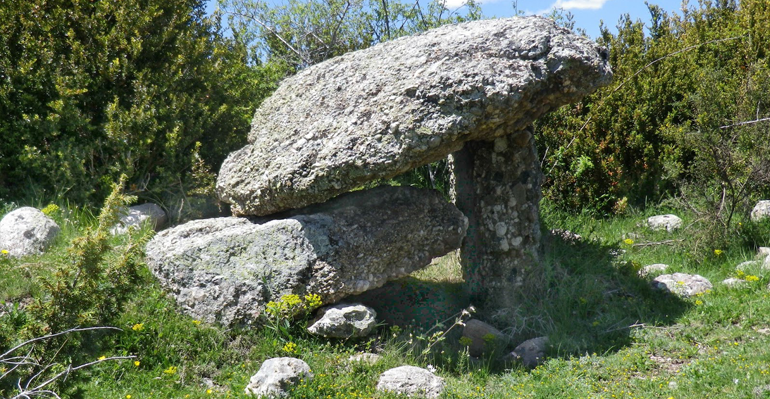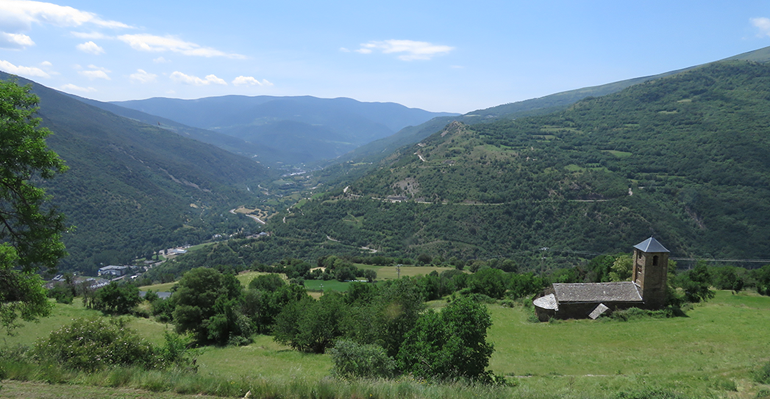
Around Senterada: A General View of Pallar's Culture
Introduction:
This is a medium-high difficulty route where you can enjoy elements of both nature and the general culture of Pallar’s in its different aspects.
A walk that combines enjoying points with spectacular views over the entire region in the towns of Cèrvoles or Naens offering a deeper understanding of the area’s diverse landscapes.
See very diverse elements that link geology with architecture from the most ancestral, such as-dolmens and necropolis, to a variety of current constructions of houses, churches or dry-stone walls.
Walk through the interior of a mature forest with a high diversity of flora and fauna where you can experience the feeling of tranquillity and peace.
Finally, understand and take part in activities carried out by local population to maintain their food sovereignty and local traditions linked to agricultural production and Pallar’s culture in its most immaterial expressions: language, myths, traditions - all very visible in the accommodation of Casa Leonardo.
What you'll discover:
Cèrvoles:
A small municipality offering a breathtaking panoramic view over the entire Pallars region.
Dolmen de La Cabaneta del Moro:
Megalithic structure dating back around 10,000 years and accompanied by a necropolis or funerary city.
Tremoluga de Naens:
A mature forest, home to a great diversity of local plant and animal species where calm is breathed in.
Comunitary Senterada Orchards:
A recently created orchard as a response to the global COVID-19 crisis promoting collective food autonomy.
Why this trail matters:
This trail helps travelers to:
- Understand the diversity of landscapes from the lowlands of Pallars Jussà to the alpine peaks of Pallars Sobirà, the different types of vegetation and the traditional and historical use that has been made of the territory: from animal grazing to the production of vegetables, wood, or rock for construction, today all in decline.
- Have a broad perspective to understand the geological importance of the place and its relationship with local architecture. See ancestral architecture, for example, the Dolmen and other funerary monuments from 10,000 years ago and the use of geology in current architecture in houses, religious or structural constructions such as dry-stone walls and be able to understand the evolution of construction techniques.
- Enjoy a quality mature forest Tremoluga de Naens where you can see a good example of high diversity of many of the most spectacular species in the region in flora - oak and aspen forests, fauna species of woodpeckers or birds of prey, or fungi and mushrooms.
- Be able to learn first-hand about the productive projects of collective organization that recover local agricultural varieties and the knowledge of the tangible and intangible Pallara’s culture vocabulary, oral traditions, legends, etc. also well represented in the accommodation of Casa Leonardo, a small rural museum.
Heritage Trail Map:
Heritage Trail Details:
- Length (km):
- 11km
- Level of difficulty:
- Middle - 310m slope
- Duration:
- 7-8 hours
- Getting there:
- Public transport to La Pobla de Segur
- Taxi / private transport / walking to Senterada
- Clothing:
- Comfortable hiking shoes
- Weather-appropriate clothing for outdoor exploration
- Tools needed:
- Camera for capturing tile discoveries
- Map or GPS for navigating the journey
- Binoculars
- Nature field guides
- Safety guidelines:
- Sloping and unstable terrain
- Not recommended in winter
- Guiding:
- Self-guided (on your own)
- Contacts for more details:
- Naturalwalks
www.naturalwalks.com
+34 662 251 059
info@naturalwalks.com - Consell Comarcal del Pallars Jussà. Epicentre centre de visitants del Geoparc Orígens
+34 973 635 470 / 693 100 336
Pg del Vall 13, 25620 Tremp
epicentre@pallarsjussa.cat - Casa Leonardo
info@casaleonardo.net
+34 973 661 787 - Associació Senterada municipi Viu i sostenible
senteradaviu@gmail.com
- Naturalwalks
Quests / Chances to be creative:
Quest 1: 'Around Senterada: A General View of Pallar's Culture'
Mission Overview
This is a walk where the traveler will be able to have a broad view of very diverse cultural aspects - both material and intangible - related to the nature of the Pallar’s area environment.
Success criteria
Travelers should be able to:
- Identify the diversity of landscapes that Pallars has as an identity element: high mountains, mid and low mountains, plain and riverside areas and how seasonality marks the image of these landscapes throughout the year.
- Identify different types of geological materials and how these can be associated with ancient constructions -dolmens, houses, churches, walls separating properties, etc.-
- Relate the local economy - cultivation of fodder, livestock production, vegetable gardens, etc. with the landscape and climatology of each place.
Quest Questions
- Could you give us some examples of how local constructions are associated with the types of stone or materials in each area?
- Could you give some examples that you have seen along this or other routes?
- Can you identify different types of livestock in the area? And could you comment on whether there is any relationship between what type of animal you have seen and where they live?
- Could you identify different types of forests typical of the region? Some have given names to emblematic places of local nature.
- Could you imagine what changes in the landscape and in people's lives are caused by changes in the climate throughout the year?
Final thoughts
It is important that the walk, especially if guided, can give rise to reflections on how seasonality in mountain and isolated places can change the landscape, for example, with snow in winter and draught in summer.
It should also show the ability of local communities since ancient times to find solutions of many types—architectural, food production, agricultural, etc.—through the observation and use of the immediate nature of each specific place. Today this is reflected in types of crops, constructions, livestock production, and even intangible cultural heritage such as legends, popular stories, and local dialects.
Equally important is the role of cultural practices that have nearly disappeared today, such as transhumance over long distances crossing all of Catalonia to the southern regions as a way of adapting to seasonal changes. This tradition has also left a strong mark on both the tangible and intangible cultural heritage of the area.

